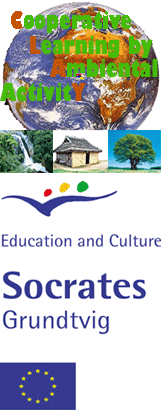|
|||||||||||||||||||||||||||||||||||||
|
|
Meeting in Schrobenhausen in July 2007 | ||||||||||||||||||||||||||||||||||||
|
6th project meeting 17. - 22. July in Schrobenhausen / Deutschland (Germany)
See the newspaper-report from the Aichacher Nachrichten in German Tuesday, 17th July 2007 Arrival of the Italian-group (11.05 by HLX 1451) Arrival of the Cyprus-group (14.05 by A3 1801L) Hotel Münchner Kindl, Damenstiftstr. Wednesday, 18th July 2007 Arrival of the Greece-group (11.30 by OA 177) Hotel Munich Inn, Goethestr. 15 (Ecke Schwanthalerstr.) Thursday, 19th July Responsible for the program: Werner Friedl (0049–160–8402720) 09.00 Train S-Bahn S4 from the Tunnel-station to station Maisach, arrival 09.28 (please buy a partner-day-ticket (Partner Tageskarte) for 5 persons for 18,00 EUR) 09.30 From Station Maisach by car to Schmiechen 10.00 Visit of a Photo-voltaik- and “Biogas” - area in Schmiechen (Herr Bichler) 11.00 Visit of the private Passiv-House Friedl in Adelzhausen (Architekt Friedl) 11.30 Press-meeting with Herrn Bürgermeister Goldstein nearby the Passive-House, Option: Meeting with the Mayor Herrn Bürgermeister Goldstein in the town hall of Adelzhausen 12.30 Meal in a local farmers market in Dasing 14.00 Trip to Augsburg and visit of a Plus-House during the built-phase (Architekt Friedl) 14.15 Press-meeting by the Plus-House in Augsburg 15.00 Visit of the centre of Augsburg 15.00 “Golden Room” (in the town hall); Meeting with Mrs. Andrea Gehler the leader of the European-direct-office-Augsburg After the Meeting: City guide (in English) by Regio Augsburg to see the “Fuggerei” (the first social living buildings, the Cathedral and the Roman ruins 18.00 Meal in Augsburg 21.00 Trip from Augsburg to Maisach 22.12 From the station Maisach to München with the suburban train S-Bahn S4 (arrival 22.44) Report about Thursday, 19th July, by Werner Friedl, architect 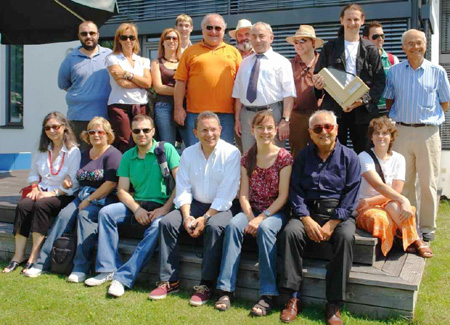
In front of the Passivhaus „Friedl“ in Adelzhausen. Oben links: Stylianos Marrogenidis (Griechenland), Angela de Giglio (Italien), Margarita Moese (Zypern), Johannes Fichtner, CLAY Koordinator Roland Schneidt, Josef Bichler, Bürgermeister Thomas Goldstein, Peter Mießl, Werner Friedl, Stelios Kakos (Griechenland), Panicos Athanassiou (Zypern). Von links sitzend: Christl Schneidt, Domenica Trentadue (Italien), Konstantinos Katrantzis, (Griechenland), Guiseppe Angiuli (Italien), Simone Bichler, Antonio Pacifico (Italien), Brigitte Streber (Bund Naturschutz). Biogas processor with combined solar panels We saw the first project at approximately 10 o`clock in the morning, near a small village “Schmiechen” for a biogas processor with combined solar panels. Mr. Bichler was one of the coordinators for realisation of this project. 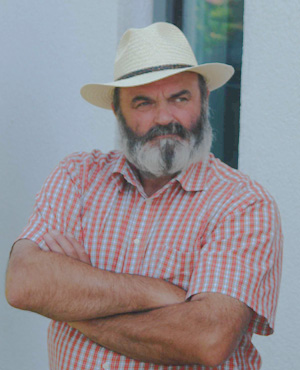
Mr. Bichler, Sielenbach (Germany) This combined biogas processor with solar panels on the roof of the storage area for biomass were avowed by Mr. Bichler and one of the owner of this processor. The asset in service is one of the biggest in the county. Five organic farmers are responsible for the processor. 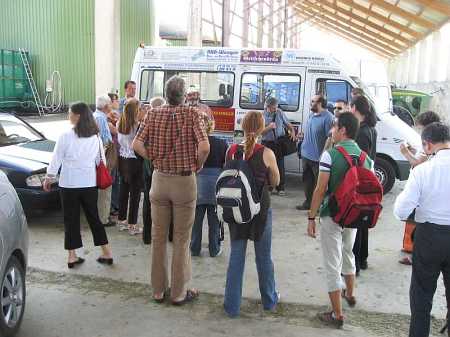
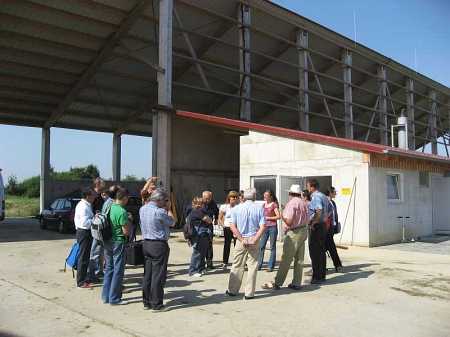
Engineering figure: biomass processor * 333 kW output of electric current (2.500.000 kWh/year) * Otto engine with biogas * Standing fermenter (1500 m3) * Five organic farmers fill the fermenter * Predominantly filled with clover * Approximately 600 kW output of unused heat energy * Beginning of operation Dec. 2005 Engineering figure: solar panels (PV- facility) * 430 kWp (peak-output) * Global radiation 1304 kWh/m2 * Number of panels 2016 type: City-Solar PQ 200 * Four power inverter type: solar max 100 C * 493.000 kWh output of real electric current in the first year * Beginning of operation Oct. 2005 Living in a passive house is like living in a thermos flask - Passive House in Adelzhausen At 11 o`clock we drove to a passive house in Adelzhausen. It is the personal living and working house of Architect Friedl. This often publicized Passive House was built in the year 2001 and was one of the first passive houses in southern Germany. 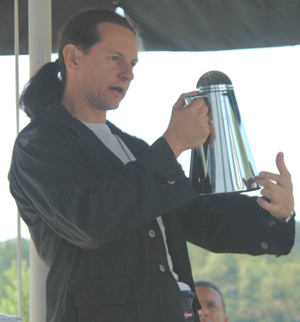
Architect Friedl, Adelzhausen (Germany) The Passive House is the world`s leading standard in energy efficient construction. Passive Houses are buildings which assure a comfortable indoor climate in summer and in winter without needing a conventional heat distribution system (under climatic conditions prevailing in central Europe). It is not an energy performance standard, but a concept to achieve the highest thermal comfort conditions with low costs. The standard has been named “Passive House” because the “passive” use of free heat gains – delivered externally by solar irradiation through the windows and provided internally by the heat emissions of appliances and occupants – essentially suffices to keep the building at comfortable indoor temperatures throughout the heating period. The Passive House saves over 80% on heating compared to new houses; for older houses, average energy savings up to 10-15 ach are possible. The energy requirement for heating is lower than 10 to 20 kWh/(m2a), adding up to a low cost of 10 to 25 € per month. This small space heat requirement can be met by heating the supply air in the ventilation system – a system which is necessary in any case. 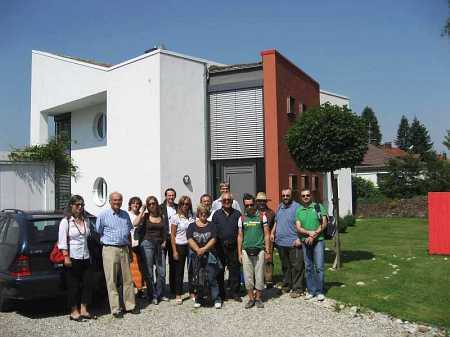
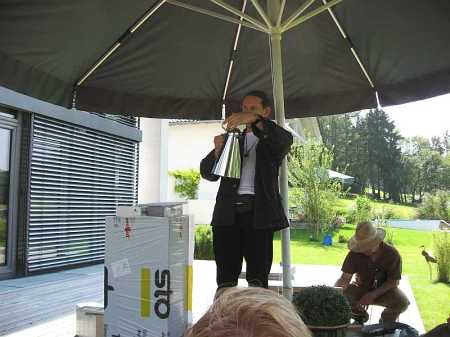
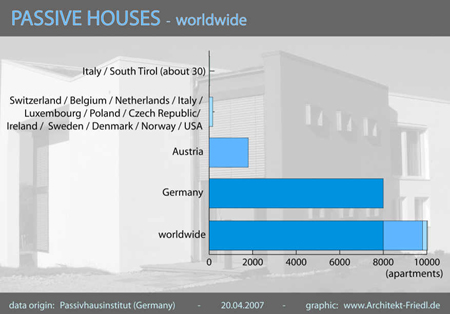
© graphic Architect Friedl, Adelzhausen (Germany) Meeting in the city hall of Adelzhausen At 12 o`clock the mayor of the municipality of Adelzhausen Mr. Thomas Goldstein received our group in the city hall. He appreciated our staying here in Adelzhausen. He spoke about the history and the presence of his community. The delegations of Cyprus, Greece and Italy presented him with some gifts. 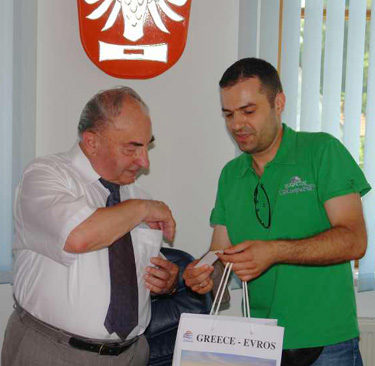
Mayor Goldstein (left, Germany) and Konstantinos Katrantzis (Greece) Meal in a local farmers market in Dasing On the way to the next project, we stopped at a local farmers market near Augsburg to have lunch. All the products are produced by the rural farmers. Our lunch took about 1 hour. 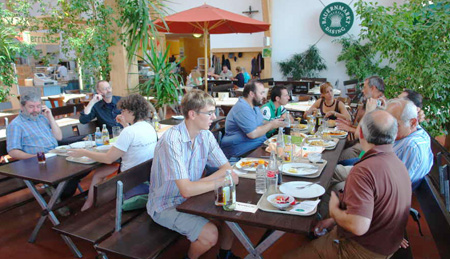
Lunch at a farmers market in Dasing Trip to Augsburg and visit of a Plus-House during the build-phase At 14.15 o`clock we arrived in Augsburg to see one of the first Plus-House in Passive House construction in Germany. We saw the building during the built-phase. The architect was also Mr. Werner Friedl from Adelzhausen. The Plus-House collects additional renewable energies and loses almost no energy, because of the “thermos flask standard - Passive House Standard”. The heating energy balance in a year is positive. This is the reason it is called a Plus House. But the basis for the building is the Passive House Standard to guarantee the excellent construction. The owner of the building, Mr. Soukup addressed the group in his new house. Mr. Friedl and Mr. Soukup explained the function of the Plus-House. Architect Friedl said: “…..it is more and more important to keep the building also cool in summer time also, with no cooling energy in the summer period….”. 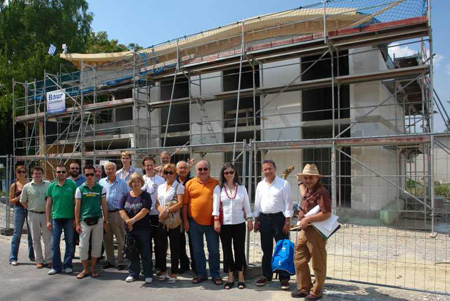
The Delegations in front of the Plus-House during the build-phase 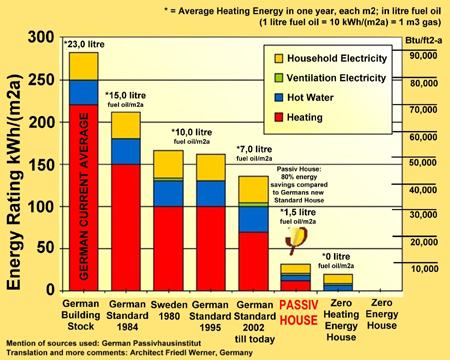
The Heating Energy is less than Zero in a Plus House © graphic Architect Friedl, Adelzhausen (Germany) Visit to the center of Augsburg At 15.30 o`clock we had a meeting with Andrea Gehler the leader of the Europe-direct-office-Augsburg in the “Golden Room” in the town hall of Augsburg. 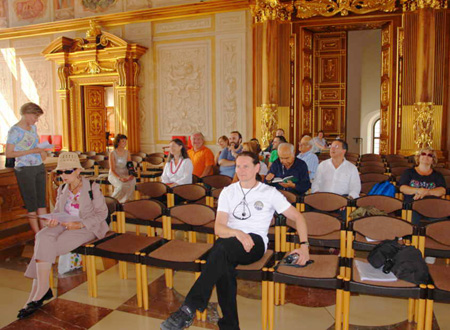
Andrea Gehler and the group in the “Golden Room” in the town hall of Augsburg. The Romans founded Augsburg in 15 BC and this makes it the oldest town in Bavaria, the second oldest in Germany. The center of the city is the picturesque “Renaissance Town Hall” and the “Perlach Tower”. Elias Holl built the town hall with the “Golden Room”. At an English spoken guided tour we saw many interesting sights of Augsburg and we learned something about the Fugger Family. Fugger was the richest man in the world. 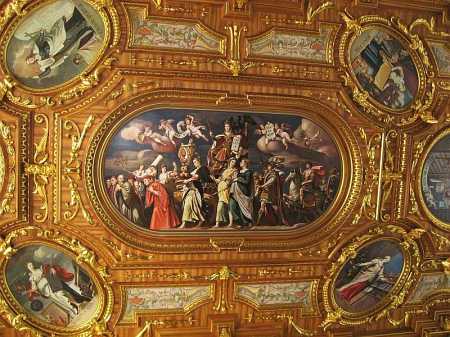
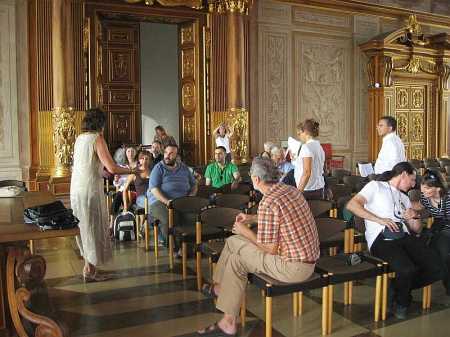
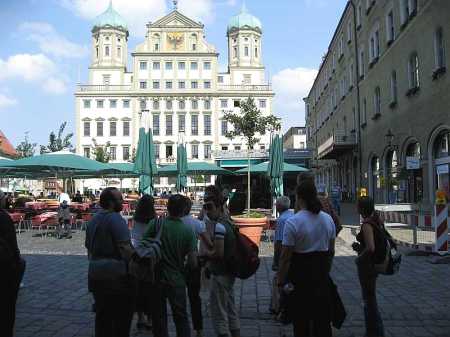
The day ended with a dinner at the “Ratskeller” in Augsburg. Ratskeller is the famous restaurant in the lower lever of the Town hall. 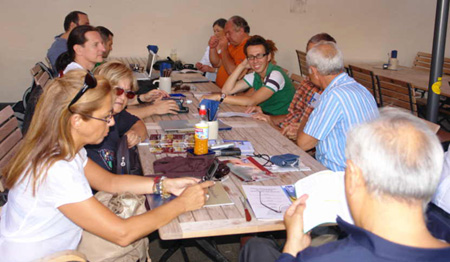
Dinner at the “Ratskeller” in Augsburg The summary of the project day It was one of the hottest days of the summer. Temperatures up to 37 degrees Celsius were not typical for normal German weather. We could feel the climate changes by the project work. It was a long day and the delegations of Cyprus, Greece, Italy and Germany had collected a lot of material to discuss at the next meeting. Responsible for the program: Werner Friedl, architect (Thanks to Tom Lappas, Las Vegas, USA for proofreading. © unchanged copy is permitted, please give reference to the author) Friday 20th Juli 2007 Responsible for the program: Benno Bickel 09.05 Regional train Nr. RE 4036 leaves from Munich Central Station to Petershausen (– Ingolstadt) (15 minutes, please buy a partner-day-ticket (Partner Tageskarte) for 5 persons for 18,00 EUR) 09.20 Transfer from station Petershausen to Schrobenhausen by bus or car. 10.00 Meeting at Volkshochschule Schrobenhausen (vhs) 10.10 Welcome and guided visit of the historic building of Volkshochschule Schrobenhausen by Benno Bickel (headmaster of the vhs) 10.40 Clay Project meeting in the “Blue Room” of Volkshochschule Schrobenhausen 10.45 Roland Schneidt: Project development 11.10 Dipl.-Ing. Landespflege (FH) Renate Schwäricke (environment protection scientist): „Precautionary flood protection for Schrobenhausen in consideration of the EU water framework directive“ 11.30 Benno Bickel: „Adult education and ecological awareness: Results of a long term study 1991 – 2006“ 12.00 Lunch prepared with ingredients from local organic food producers, examples of local production principles according to Agenda 21 (balance of economic, environmental and social aspects). Prepared by Margaretha Sandner (teacher of vhs) 14.00 Brigitte Streber (Chairwoman of local nature protection association) and Benno Bickel: „Landscape protection and adult education: 'The Goachat' – a case study“ 14.30 Filmmaker Günther Heidemeier presents his documentary film about the local landscape protection area “Goachat” 15.45 Excursion to the local landscape protection area “Goachat” and guided visit along the river Paar's wetland by Brigitte Streber and Renate Schwäricke 17.30 Freetime, you can have a little meal in a local Gasthaus 19.00 Final graduation ceremony in Franz-von-Lenbach-Schule Schrobenhausen 22.00 Transfer to railway station Petershausen by car (please meet in the school-yard at 22.00) 22.33 Train RE 4053 from Petershausen to Munich central station, arrival 22.53 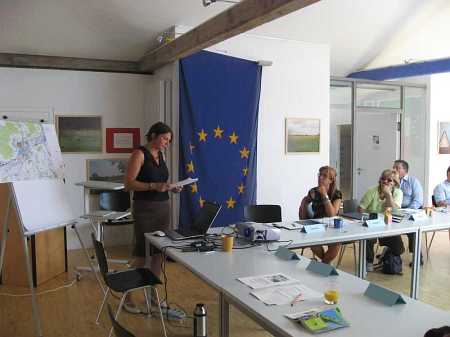
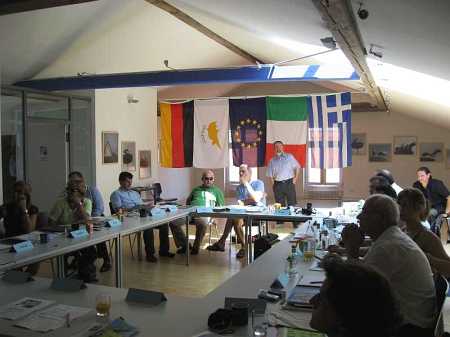
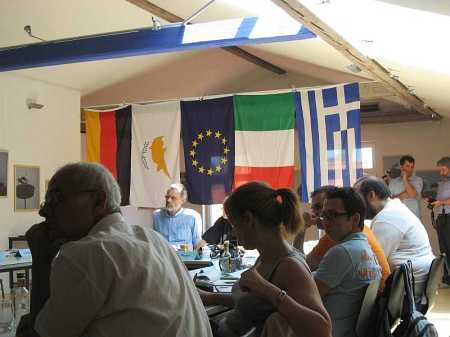
Saturday, 21st July 2007 Culture-Program 18.00 Meeting in Ratskeller Sunday, 22nd July 2007 Departure of the Italian-group (07.10 by HLX 1450) Hapag Lloyd Departure of the Cyprus-group (09.20 by A3 1806L) Aegean Airlines Departure of the Greece-group (12.20 by OA 178) Olympic Airwais Roland Schneidt 0049-173-4133492
|
|
|||||||||||||||||||||||||||||||||||

